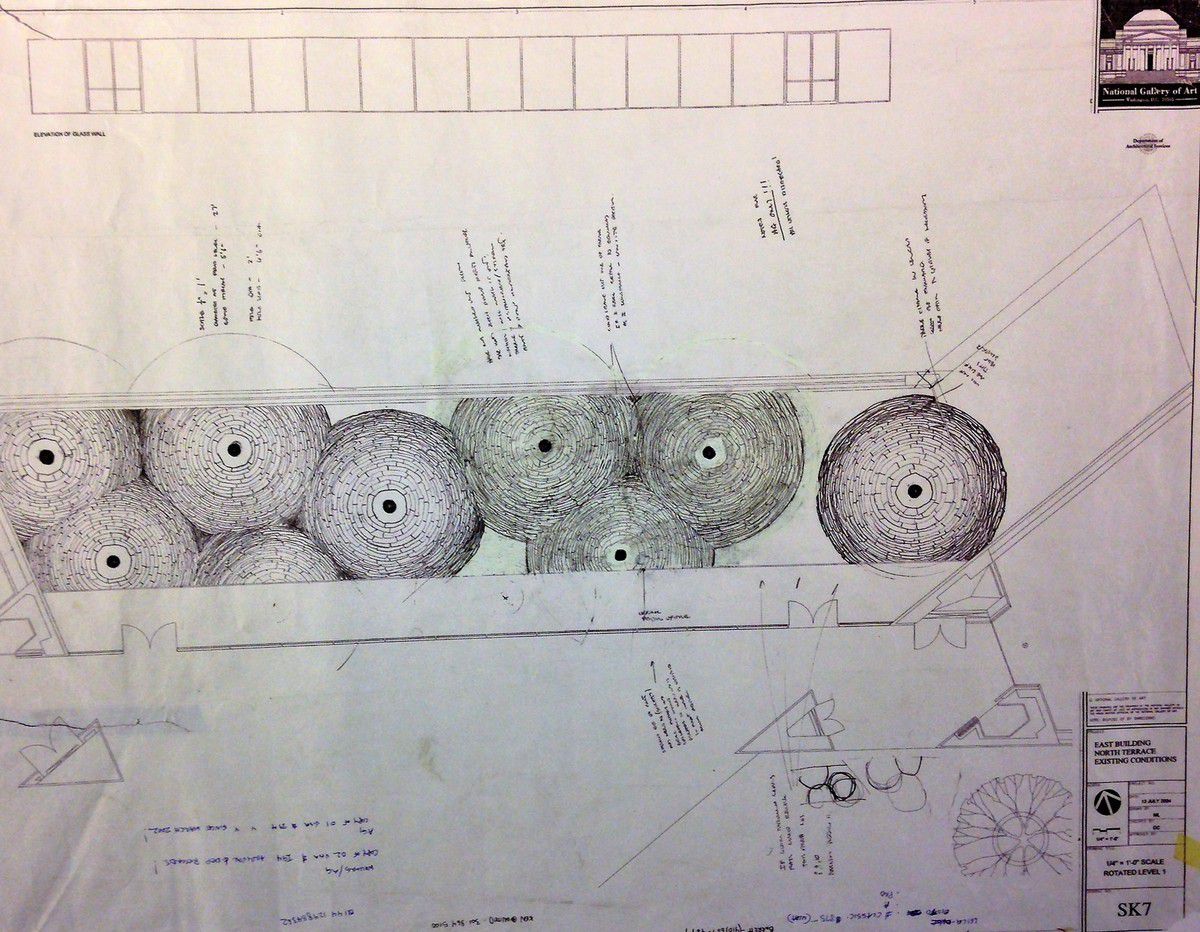Decoding a black hole
Andy Goldsworthy’s Roof at the East Building of the National Gallery of Art in D.C. The installation is composed of nine stacked slate domes as if they were black holes at the center of nine galaxies – tiny cells where matter is kept prisoner and light disappears in the dark, where information is trapped and knowledge is lost without a trace.
In a cosmological natural selection, black holes like stars follow their evolutionary path. Some are gluttonous giants absorbing their surrounding; others are small on the path to growth or waiting to disappear. And there are “prehistoric” ones called primordial whose existence we have no evidence. Some are supermassive; some are stellar. Others meet in an epic encounter. And some are born of a collapsing star, a destination that reminds us of our own demise. That is why we’re eager to know whether Singularity where all things go is a gate to something else.
Decoding a black hole is in a sense measuring and constantly reevaluating the spread of information around and in and out of it. The universe structures and destructures itself through the dispersal of matter and energy, the formation of galaxies and the pull of black holes. The cosmological natural selection has currently its share of impredictabilities and uncertainties.
“If this universe is the best of all possible universes, so what are the others like?” Les aventures d’Anselme Lanturlu:Trou noir, Jean-Pierre Petit, Paris: Belin [1981]
The birth of a black hole requires the right stuff. If it rises up of one or more disappearing core, as a result of two neutron stars merging in some far away region of space, scientists will explore and study them. They rely on instruments to collect data and on computers and algorithms to decipher the findings. Since the recording of a gravitational signal emitted by the merger of two black holes in September 2015 by the Laser Interferometer Gravitational-wave Observatory (LIGO), we learned over the past year or so of a number of discoveries - thanks to optical images and the detection of X-rays, gamma rays, radio waves and gravitational waves - such as a neutrino emission detected by the Icecube neutrino Observatory and traced back by Fermi’s Large Area Telescope to a supermassive black hole in the constellation Orion, a black hole bounty at the edge of the center of our galaxy and an outburst on its edge that ended about one hundred years ago, two giant black holes orbiting each other in Andromeda galaxy and two accretion events around the boundary of an active galactic nucleus. We learned of the growth rate of supermassive black holes and understand that their merger does not “overshadow” the evolution of their accretion disks. Will they themselves evaporate in a succession of eons or are they central in a multiverse theory? And where does the information fallen into a black hole go anyway? From our standpoint, crossing the event horizon of a black hole equals to an information loss. But a black hole sometimes active sometimes quiet swallows, digests and burps. At times a supermassive black hole may even spew out relativistic jets while integrating the infalling mass and energy.
The laws of Nature are information about information and outside of it there is darkness. This is the gateway to understanding reality
The study of black holes raises the issue of white holes through which matter and energy might crawl out in a life-like cycle of birth and death. Our Earthbound common sense whispers in our ear: “if you dig a hole deep enough you sure can get to the other side” through space and time wherever it might be. A paper on white holes argues that a white hole is produced at the end of the evaporation of a black hole and that a component of dark matter could be formed by remnants of evaporated black holes. On the concept of a “time capsule” connecting a black hole to a white hole, should an outside observer follow the ultimate judgement of the scientific community that black holes are invisible and a one-way ticket to where no one can ever return and white holes could exist but that doesn't mean they do or should we go further down the poet’s path?
That there is no consensus stems from two reasons: first, despite black hole animations like those made by Andrew Hamilton using a Black Hole Flight simulator and study of what happens in the boundary around black holes like at the Brookhaven National Laboratory’s Relativistic Heavy ion Collider, observing cosmological events given the orders of magnitude, testing theories and modelling numerically is a monumental task. Second, every theorist begins with its own intuitive knowledge upon which intuitive structures are built into logically connected concepts.
The universe is an information system whose data we are bound to process and a black hole is a lack of information that our imagination fills with a tendency to speculate and theorize. It is the ultimate door that fuels human creativity in multinational and multi-institutional endeavors meant at future discoveries in the quest of the first galaxies, the study of the evolution of black holes and the ultimate pursuit of the beginning of our universe such as with the Event Horizon Telescope, the James Webb Observatory and the First Gravitational Wave Observatory in Space (LISA) as well as with NASA Imaging X-ray Polarimetry Explorer (IXPE) mission selected in 2017 to be launched in 2020.
The beauty of a black hole is that we allow ourselves to imagine any possibilities. Tugged between “I think therefore the Universe is” and “the Universe is therefore I think”, I do not know how consciousness relates to the universe but if I dare to apply the framework of the Integrated Information Theory to mechanisms of the universe, I imagine the universe to be a conscious system and that black holes as regions of the universe exist from their own intrinsic perspective. They are an essential component of a self-organizing system within a cosmological natural selection, pulling over the edge and tunneling down matter and energy, acting as regulators of the universe. The question remains: whether the above-mentioned “perspective” is intrinsic or extrinsic? Clearly if the hypothesis is that a black hole is an endpoint, then it is the latter. If we are to believe that a black hole acts as an informational traffic hub, then there is an intrinsic dimension attached to a black hole. If time’s arrow is perspectival, the information fallen into a black hole could evolve forward from the past, and an unknown information evolving backward from the future could be coded into erebons as referred by Roger Penrose to matter crossing over from one eon to the successive one.
A dream of a final theory can only include a theory of consciousness. Information is the link between the universe and consciousness. In the universe whose stardust we are made of, consciousness emerges at a quantum level and when it crosses the event horizon of countless black holes, it collapses into something that very much reminds me of a state of unconsciousness. If a particle of matter or energy can be described in mathematical terms as a wave, can I, as a poet, name it a wave of consciousness?
Consciousness extends through gravitational waves. That is how stars and black holes communicate. How to test a wave of consciousness against observation? The observer effect takes here center stage. If only theories that could be put to the test were worth of value, science would dismiss the unknown beyond the reach of experimental evidence. A physicist who wonders how to evaluate the quality and quantity of consciousness falling into a black hole might reflect upon the fact that biochemist Nick Lane and geneticist David Reich are faced with a similar problem: In evolutionary biology, a black hole pertains to a missing link at the outset of life or at different stages of the evolution be millions or hundreds of thousands years ago on a deep time journey from one branch to the other of the phylogenetic tree. And if an astronomer peers through a telescope as a way to look back at the lost memory to the time when the Fermi bubbles formed a few million years ago out of the Milky Way’s galactic center, she might dream of our common ancestors staring at the sky.


![“If this universe is the best of all possible universes, so what are the others like?” Les aventures d’Anselme Lanturlu:Trou noir, Jean-Pierre Petit, Paris: Belin [1981]](https://img.over-blog-kiwi.com/3/09/36/45/20190105/ob_f9ceb5_img-1014-2.JPG)

